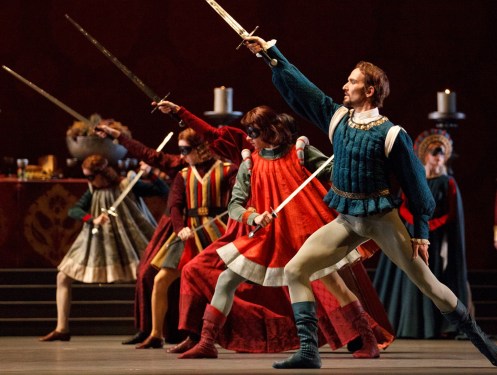National Ballet of Canada
Romeo and Juliet
Reviewed January 31, 2013
NAC Southam Hall, Ottawa
(Repeat performances through to February 2, 8 p.m.)
It’s a timeless story, a tender, tragic and brave story, and one that’s been loved since Shakespeare penned the tale. It’s been danced by ballet companies around the world forever. It’s classical. It’s traditional. And yet the National Ballet, thanks to its decision to invite the Russian-born choreographer Alexei Ratmansky to update its staple production, has created a brand new take on Romeo and Juliet.
Commissioned to kick off the National Ballet Company’s 60th anniversary season in November 2011, this enormous $1.7 million production is superb in every detail. Now on tour, it is garnering rave reviews and standing ovations.
Award-winning set and costume designer Richard Hudson has washed the stage with a simple, yet effective Italian Renaissance village look. Clean lines. Rustic, warm earthy colors, infinitely aesthetically pleasing. Same for the costumes. Flowing lines, nothing overstated, and yet a beautiful reflection of the era. Lords and ladies, in their elegant billowing dress of silks, velvets, shimmering gowns, bold headdresses and long flittering veils are distinct from the gaily habited village youth, clad in clever complementary pairings of color, who are again distinct from the titular characters of Romeo and Juliet, who are mostly clad in white and neutral tones, nicely speaking to their youthful innocence.
Sergei Prokofiev’s score, first composed for the Kirov Theatre’s Romeo and Juliet in 1935, is so perfect for the story, melodic, passionate, and beautiful. The initial bars seemed particularly light and joyful on opening night, possibly because I had just entered the theatre from the biting cold.
Nevertheless, the gaiety of the orchestra heralds in the first act of the ballet, which is rife with the frivolity of youth, performed wonderfully by the accomplished corps de ballet. In fact, it is noticeable how much dancing the corps does in this production. They dance, leap, fly, bustle, tease, and engage in swordplay in nearly all the scenes, adding a contagious exuberant energy to the performance.
The final, third act is the sombre finale of the tale. The strings grow sober, the wind instruments woeful, the percussion pounding. And Guillaume Côté and Elena Lobsanova, as Romeo and Juliet respectively, shine in the final bedroom scene. While the ballet has been on stage for more than two hours by this time, this scene is riveting enough to keep you on the edge of your seat. The protestations of Juliet against her parents’ wishes for her to marry Paris are brilliantly choreographed. There’s anger and despair and hope and fear and it’s all dramatized with bold flair, not only by Lobsanova, but also Alejandra Perez-Gomez as Lady Capulet and Jonathan Renna as Lord Capulet.
Lobsanova and Côté are a well-suited pair to perform as the star-crossed lovers. Lobsanova flutters from the naiveté of youth, and flirtation with Romeo at the ball, through to the oppression of her family and the despair of losing her lover. Her dancing is remarkable. Côté’s portrayal of Romeo is untouchable. Together, they are flawless.
When Romeo and his friends, Mercutio and Benvolio, performed by Piotr Stanczyk and Robert Stephen respectively, sneak into the Capulet ball in disguise, the trio bring a playful touch to the story in a beautiful comical performance that displays the musicality of the choreography. Stanczyk, in particular, dramatizes his character’s death in the market square in a witty and charming show of talent.
The Nurse is also an engaging character, buried in the billows of her stark white uniform, portrayed with charm by Lorna Geddes.
